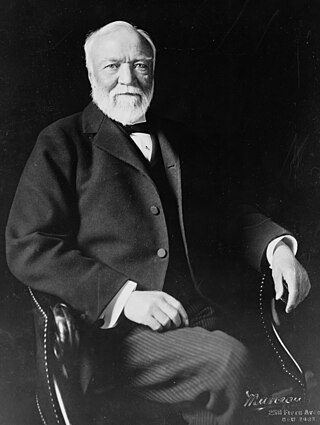
Andrew Carnegie was an American industrialist and philanthropist. Carnegie led the expansion of the American steel industry in the late 19th century and became one of the richest Americans in history. He became a leading philanthropist in the United States, Great Britain, and the British Empire. During the last 18 years of his life, he gave away around $350 million, almost 90 percent of his fortune, to charities, foundations and universities. His 1889 article proclaiming "The Gospel of Wealth" called on the rich to use their wealth to improve society, expressed support for progressive taxation and an estate tax, and stimulated a wave of philanthropy.
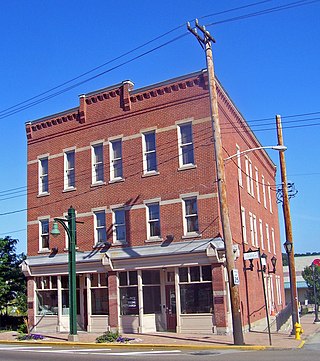
Homestead is a borough in Allegheny County, Pennsylvania, United States, along the Monongahela River 7 miles (11 km) southeast of downtown Pittsburgh. The borough is known for the Homestead strike of 1892, an important event in the history of labor relations in the United States. The population was 2,884 at the 2020 census. It is part of the Pittsburgh metropolitan area.

The history of Pittsburgh began with centuries of Native American civilization in the modern Pittsburgh region, known as "Dionde:gâ'" in the Seneca language. Eventually, European explorers encountered the strategic confluence where the Allegheny and Monongahela Rivers meet to form the Ohio, which leads to the Mississippi River. The area became a battleground when France and Great Britain fought for control in the 1750s. When the British were victorious, the French ceded control of territories east of the Mississippi.

Henry Clay Frick was an American industrialist, financier, and art patron. He founded the H. C. Frick & Company coke manufacturing company, was chairman of the Carnegie Steel Company and played a major role in the formation of the giant U.S. Steel manufacturing concern. He had extensive real estate holdings in Pittsburgh and throughout the state of Pennsylvania. He later built the historic Neoclassical Frick Mansion, and upon his death donated his extensive collection of old master paintings and fine furniture to create the celebrated Frick Collection and art museum. However, as a founding member of the South Fork Fishing and Hunting Club, he was also in large part responsible for the alterations to the South Fork Dam that caused its failure, leading to the catastrophic Johnstown Flood. His vehement opposition to unions also caused violent conflict, most notably in the Homestead Strike.

A Carnegie library is a library built with money donated by Scottish-American businessman and philanthropist Andrew Carnegie. A total of 2,509 Carnegie libraries were built between 1883 and 1929, including some belonging to public and university library systems. 1,689 were built in the United States, 660 in the United Kingdom and Ireland, 125 in Canada, and 25 others in Australia, South Africa, New Zealand, Serbia, Belgium, France, the Caribbean, Mauritius, Malaysia, and Fiji.

Allegheny Cemetery is one of the largest and oldest burial grounds in Pittsburgh, Pennsylvania. It is a historic rural cemetery.

The Carnegie Library of Pittsburgh is the public library system in Pittsburgh, Pennsylvania. Its main branch is located in the Oakland neighborhood of Pittsburgh, and it has 19 branch locations throughout the city. Like hundreds of other Carnegie libraries, the construction of the main library, which opened in 1895, and several neighborhood branches, was funded by industrialist Andrew Carnegie. The Pittsburgh area houses the first branches in the United States.

Allegheny City was a municipality that existed in the U.S. state of Pennsylvania from 1788 until it was annexed by Pittsburgh in 1907. It was located north across the Allegheny River from downtown Pittsburgh, with its southwest border formed by the Ohio River, and is known today as the North Side. The city's waterfront district, along the Allegheny and Ohio rivers, became Pittsburgh's North Shore neighborhood.

George Edwin Bissell was an American sculptor.

The Pittsburgh City-County Building is the seat of government for the City of Pittsburgh, and houses both city and Allegheny County offices. It is located in Downtown Pittsburgh at 414 Grant Street. Built from 1915 to 1917 it is the third seat of government of Pittsburgh. Today the building is occupied mostly by Pittsburgh offices with Allegheny County located in adjacent county facilities. It also contains a courtroom used for the Pittsburgh sessions of the Supreme Court of Pennsylvania.
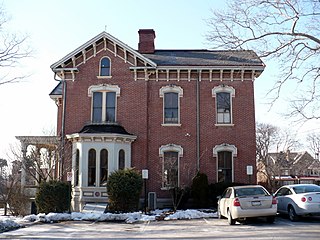
The Andrew Bayne Memorial Library is a public library in Bellevue, a suburb of Pittsburgh, Pennsylvania in the United States. The library sits on a four-acre parcel of land donated to Bellevue borough in 1912 by the daughters of Allegheny County sheriff Andrew Bayne, and houses approximately 14,000 print volumes.
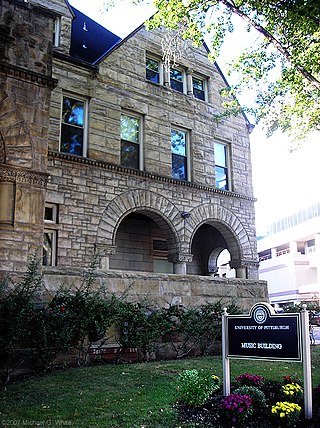
Longfellow, Alden & Harlow, of Boston, Massachusetts, and Pittsburgh, Pennsylvania, was the architectural firm of Alexander Wadsworth Longfellow Jr. (1854–1934), Frank Ellis Alden (1859–1908), and Alfred Branch Harlow (1857–1927). The firm, successors to H. H. Richardson, continued to provide structures in the Romanesque revival style established by Richardson that is often referred to as Richardsonian Romanesque.

The Carnegie Free Library of Allegheny is situated in the Allegheny Center neighborhood of Pittsburgh, Pennsylvania. It was commissioned in 1886, the first Carnegie library to be commissioned in the United States. Donated to the public by entrepreneur Andrew Carnegie, it was built from 1886 to 1890 on a design by John L. Smithmeyer and Paul J. Pelz.
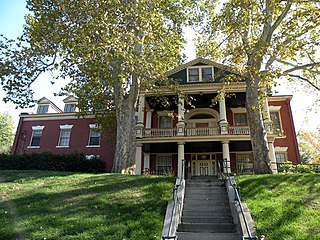
Anderson Manor located at 1423 Liverpool Street in the Manchester neighborhood of Pittsburgh, Pennsylvania, was built circa 1830. Colonel James Anderson, who lived at this house, was the man from whom Andrew Carnegie (1835–1919) borrowed books during his formative years. Anderson opened his personal library of 400 volumes to working boys each Saturday night, and helped start the first library in the area. The house was added to the List of Pittsburgh History and Landmarks Foundation Historic Landmarks in 1989.

Thomas Hannah was an architect in Pittsburgh and Philadelphia in the United States. He is credited with designing the Saint Nicholas Greek Orthodox Cathedral. He also designed the Western Theological Seminary in Pittsburgh. He also designed Midtown Towers, originally known as the Keenan Building and built in 1907. It was built for Colonel Thomas J. Keenan, owner and founder of the Penny Press, which became Pittsburgh Press. The building may have been modeled after the Spreckel Building/ Call Building (1898) of San Francisco. It is decorated with visages of 10 notables associated with Pittsburgh and Pennsylvania, including then-mayor George Guthrie and then-governor Edwin Stuart, in addition to George Washington and Teddy Roosevelt. The dome was once capped with the figure of an eagle in flight.
The following is a timeline of the history of the city of Pittsburgh, Pennsylvania, US.

The Westinghouse Memorial is a bronze monument located in the U.S. city of Pittsburgh, Pennsylvania. It commemorates George Westinghouse, an engineer, founder of the Westinghouse Electric Corporation, and inventor of the railway air brake. The memorial is located at the entrance to the Steven Faloon trail, a part of Schenley Park. The architects for the monument and the surrounding area were Henry Hornbostel and Eric Fisher Wood. Daniel Chester French was the sculptor for the statue and the main panel, and Paul Fjelde designed the side panels.
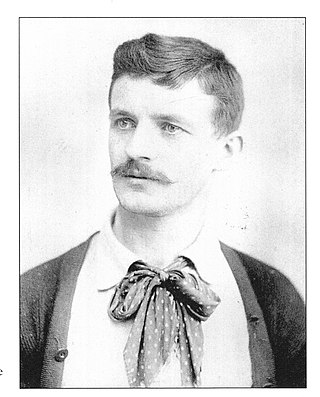
August Zeller was an American sculptor and teacher.
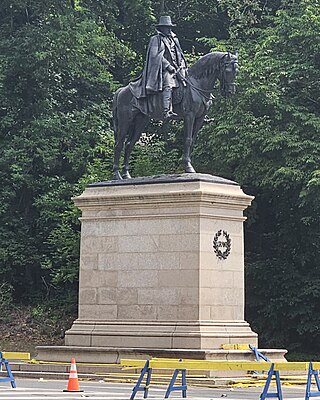
The equestrian statue of Ulysses S. Grant is a public monument in Philadelphia, Pennsylvania, United States. Located in Fairmount Park, the monument honors Ulysses S. Grant, who served as a general in the Union Army during the American Civil War and later as President of the United States. The monument was designed by Daniel Chester French and Edward Clark Potter and consists of an equestrian statue atop a pedestal. The statue was dedicated in 1899.

The 2023 Allegheny County Executive election was held on November 7, 2023, to elect the next chief executive of Allegheny County, Pennsylvania.




















